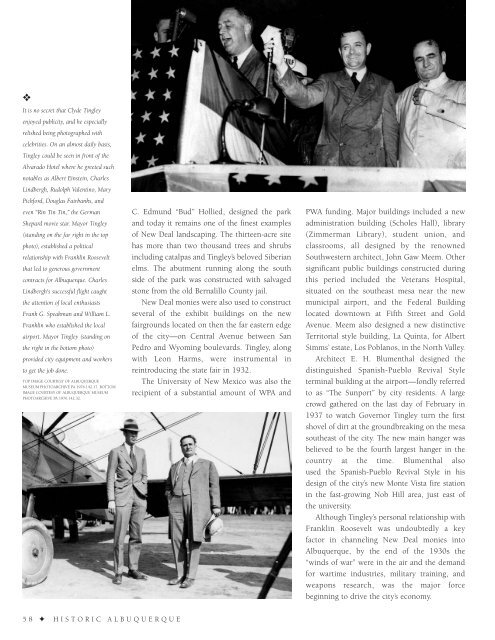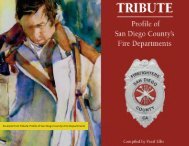Historic Albuquerque
An illustrated history of the City of Albuquerque, New Mexico and the surrounding area, paired with the histories of companies, families and organizations that make the region great.
An illustrated history of the City of Albuquerque, New Mexico and the surrounding area, paired with the histories of companies, families and organizations that make the region great.
Create successful ePaper yourself
Turn your PDF publications into a flip-book with our unique Google optimized e-Paper software.
❖<br />
It is no secret that Clyde Tingley<br />
enjoyed publicity, and he especially<br />
relished being photographed with<br />
celebrities. On an almost daily basis,<br />
Tingley could be seen in front of the<br />
Alvarado Hotel where he greeted such<br />
notables as Albert Einstein, Charles<br />
Lindbergh, Rudolph Valentino, Mary<br />
Pickford, Douglas Fairbanks, and<br />
even “Rin Tin Tin,” the German<br />
Shepard movie star. Mayor Tingley<br />
(standing on the far right in the top<br />
photo), established a political<br />
relationship with Franklin Roosevelt<br />
that led to generous government<br />
contracts for <strong>Albuquerque</strong>. Charles<br />
Lindbergh's successful flight caught<br />
the attention of local enthusiasts<br />
Frank G. Speakman and William L.<br />
Franklin who established the local<br />
airport. Mayor Tingley (standing on<br />
the right in the bottom photo)<br />
provided city equipment and workers<br />
to get the job done.<br />
TOP IMAGE COURTESY OF ALBUQUERQUE<br />
MUSEUM PHOTOARCHIVE PA 1976.142.17. BOTTOM<br />
IMAGE COURTESY OF ALBUQUERQUE MUSEUM<br />
PHOTOARCHIVE PA 1976.142.32.<br />
C. Edmund “Bud” Hollied, designed the park<br />
and today it remains one of the finest examples<br />
of New Deal landscaping. The thirteen-acre site<br />
has more than two thousand trees and shrubs<br />
including catalpas and Tingley’s beloved Siberian<br />
elms. The abutment running along the south<br />
side of the park was constructed with salvaged<br />
stone from the old Bernalillo County jail.<br />
New Deal monies were also used to construct<br />
several of the exhibit buildings on the new<br />
fairgrounds located on then the far eastern edge<br />
of the city—on Central Avenue between San<br />
Pedro and Wyoming boulevards. Tingley, along<br />
with Leon Harms, were instrumental in<br />
reintroducing the state fair in 1932.<br />
The University of New Mexico was also the<br />
recipient of a substantial amount of WPA and<br />
PWA funding. Major buildings included a new<br />
administration building (Scholes Hall), library<br />
(Zimmerman Library), student union, and<br />
classrooms, all designed by the renowned<br />
Southwestern architect, John Gaw Meem. Other<br />
significant public buildings constructed during<br />
this period included the Veterans Hospital,<br />
situated on the southeast mesa near the new<br />
municipal airport, and the Federal Building<br />
located downtown at Fifth Street and Gold<br />
Avenue. Meem also designed a new distinctive<br />
Territorial style building, La Quinta, for Albert<br />
Simms’ estate, Los Poblanos, in the North Valley.<br />
Architect E. H. Blumenthal designed the<br />
distinguished Spanish-Pueblo Revival Style<br />
terminal building at the airport—fondly referred<br />
to as “The Sunport” by city residents. A large<br />
crowd gathered on the last day of February in<br />
1937 to watch Governor Tingley turn the first<br />
shovel of dirt at the groundbreaking on the mesa<br />
southeast of the city. The new main hanger was<br />
believed to be the fourth largest hanger in the<br />
country at the time. Blumenthal also<br />
used the Spanish-Pueblo Revival Style in his<br />
design of the city’s new Monte Vista fire station<br />
in the fast-growing Nob Hill area, just east of<br />
the university.<br />
Although Tingley’s personal relationship with<br />
Franklin Roosevelt was undoubtedly a key<br />
factor in channeling New Deal monies into<br />
<strong>Albuquerque</strong>, by the end of the 1930s the<br />
“winds of war” were in the air and the demand<br />
for wartime industries, military training, and<br />
weapons research, was the major force<br />
beginning to drive the city’s economy.<br />
58 ✦ HISTORIC ALBUQUERQUE
















